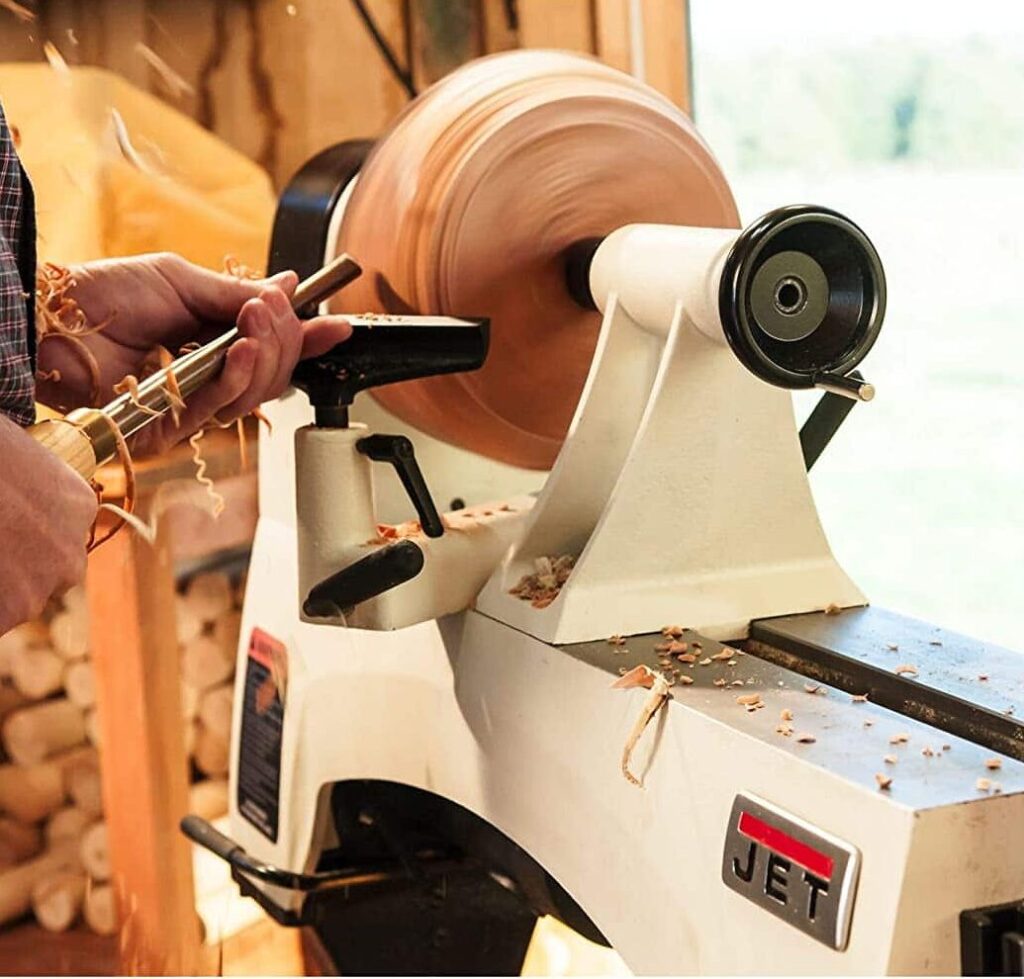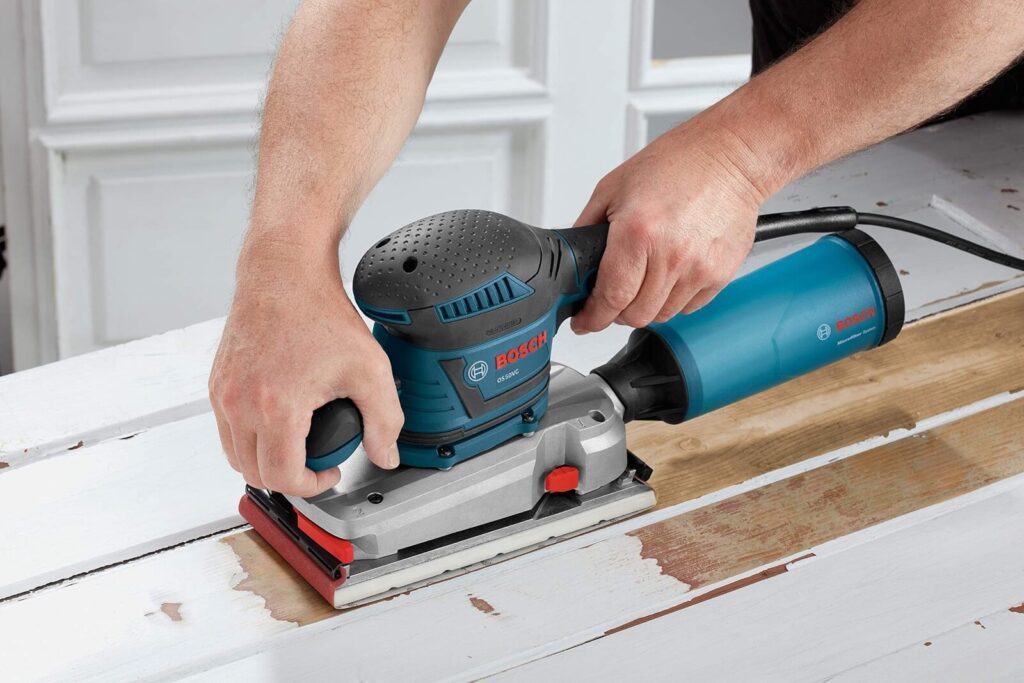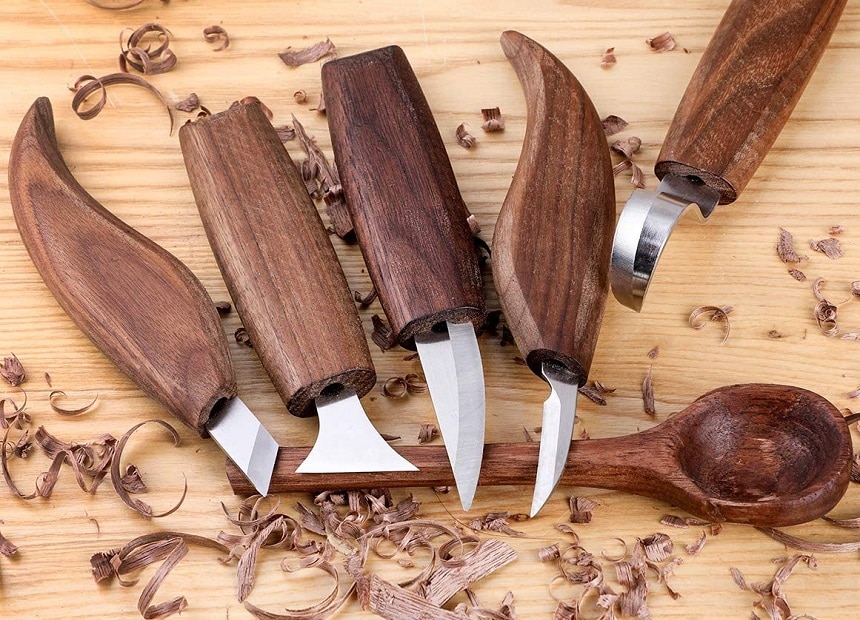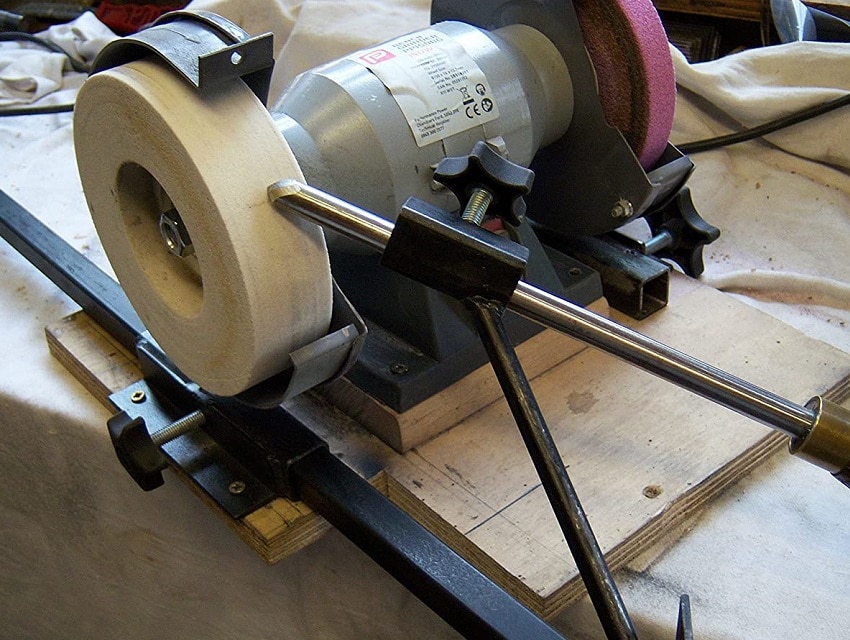

Like any other crafting field, a beginner in woodworking needs to have the best affordable tools to achieve excellence. One of the handiest tools that is an absolute must-have in your woodworking arsenal is a wood router. The best wood router for a beginner should be super-easy to use with a powerful motor that can produce 8000 revolutions per minute. If you think you know the best wood router to choose from, the endless options available on the market, then you are mistaken.
We came up with this guide to help you make the best-informed choice easily. We rounded up a few of the best-rated routers and some of the aspects and parameters that you must consider when approaching your investment. The crucial aspects include: amps, speed, weight, warranty, type, and power. They determine the overall performance, convenience, and the wood router’s ease of use.
Other features: corded-electric, soft-start, quick-lock systems, depth adjustment system, finger support pockets
This tops our list as the best beginner wood router because of various unmatched features, including an incredibly powerful motor and a variable speed architecture. Its 5.6A motor can be used at various rates. It is especially a favorite among woodworkers that specialize in cutting off molding pieces.
The router is ruggedly built with aluminum parts. It features an edging tool that you can easily position on the board’s edge before you start cutting. It also helps you do adjustments easily so you can get the right cutting depth. With it, you can forget about rough or serrated spots that are usually left on the wood after cutting.
The router generates up to 35000 RPM, but you can use it at a lower setting to get about 16,000 RPM. What’s more, the router weighs slightly less than 12 pounds, thus wouldn’t weigh you down when you work for extended periods.
Another aspect that makes this router a perfect beginner option is its ease of use. You can hold it with one hand in a comfortable position while simultaneously adjusting the cutting depth features.
What we liked: This is hands down one of the most affordable wood routers that is super-easy to use and offer fine depth adjustments. It features a soft-start system that prevents it from jumping off when turned off. On top of being affordable, the router’s superb features are backed by a 1-year warranty.
What could be better: Most users have complained that this router’s design is not quite up to scratch.
Other features: corded-electric, soft start, variable speed, trigger switch with a lock-on feature, integral through-the-column dust collection
This sits high in the premium position because it has an extremely powerful motor that can handle an increased workload more than other regular wood routers. If you are just getting started and are willing to dig a little deeper into your pockets and an efficient and reliable wood router, this is your best bet.
The router’s motor has a 12-amp current and 2¼ HP that produces a widely variable speed of up to 24,000RPM on the highest setting and 8000 RPM on the lowest setting.
Essentially, you will be able to achieve maximum performance with this router owing to its sub-base concentricity gage that allows you to focus the sub-base. As if that’s enough, the router can adjust its depth in increments of 1/64-inches, ensuring you get the finest and most accurate cuts.
In terms of versatility, it is hard to beat this DEWALT router. It has 3 different types of bases: D-handle, plunge, and fixed, from which you can pick your favorite for the best cutting result.
Most manufacturers tend to ignore dust control, especially for routers that are built to handle heavy workloads. A proper dust control system will help you save on time and energy as you wouldn’t have to clean up your workspace every time you are done. The DW618B3 has an integral-through-the-column dust collection system that allows for a vacuum fit.
What we liked: This router comes second to none in terms of efficiency and reliability. It can handle heavy workloads pretty well, so you will hardly need to upgrade when you become a professional woodworker.
What could be better: When starting the router, the engine can be a bit loud, and you will need a wrench to remove its parts. It is also a little heavier compared to others within its range.
Other features: corded-electric, adjustable speed settings, built-in Constant Response Circuitry, soft start, rugged design
We couldn’t get enough of Bosch because it offers supreme quality and convenience at an attractive price point. This particular model offers unparalleled flexibility in its design and usability.
The router comes in a rugged design and measures a convenient 18.2 pounds that wouldn’t weigh you down if you work for long. Its robust aluminum construction is meant to last and protect the engine properly. Its motor is pretty impressive with a power of 2.25HP and 12amps.
You will get a variable speed of up to 25,000RPM on the highest settings and as low as 8000RPM on low settings. With the 6-speed setting levels, you will enjoy maximum adaptability when working on different types of projects.
The router features a fixed base with collets that can accept ¼ and ½ inches of shank bits. Both the lunge and fixed base are easy to swap. Also featured is a T-handle hex height adjustment wrench that allows you to make fine depth adjustments for precise cutting.
The most distinguishing feature of this router is the continuous response circuitry that keeps its pace constant and steady.
What we liked: Nothing comes close to this Bosch’s top-tier strength and convenient one-button functionality. This makes it a fantastic option for novices, skilled, and amateur woodworkers. You don’t have to decimate your bank balance to buy it, and you get to enjoy a full year’s warranty.
What could be better: You will need an adapter for the router to work with 3rd party collars.
Other features: corded-electric, soft-starting motor, rocker switch
This is the best compact router that money can buy out there. The porter cable is slightly smaller than a mid-size router and pretty much bigger than a trim router. Like a full-size router, you can remove its motor, though it doesn’t have handles.
The machine has a very robust build with metal everywhere and no loose parts. It is engineered to last with adjustments that lock securely.
Its motor has excellent quality and produces a respectable 1 ¼ HP, which is pretty plenty considering the router’s cutter head size. The speed combined with the motor’s high torque promises aggressive and smooth cutting, especially when routing edges of your projects.
The router features a soft-start system that works quite well though it does lurch a little when started. With a firm grip, you will be able to start the router successfully.
Another noteworthy thing is that the router only supports a ¼-inch collet. Its motor shaft is too tiny to mount a ½-inch collet.
On the bright side, the router will offer you great stability when making cuts thanks to its sturdy base made with a single piece of metal. Unlike many wood routers, the motor fits tightly into the base such that you wouldn’t need a lot of pressure to secure it.
As much as the 450 lacks a proprietary dust collection system, it is designed to evacuate all dust through its base plate without clogging. If you intend to work on finished spaces that need cleaning afterward, then this router should be your top priority.
What we liked: This router is a perfect mix of power and size. It weighs a mere 5 pounds and can be held with one hand. Despite its size, the router offers excellent depth adjustment and dust collection. Plus, you get a 3-year warranty.
What could be better: When starting the router, the engine can be a bit loud.
Other features: corded-electric, variable speed control, soft-starting motor, dual LEDs, and clear sub-base
Yet another gem from the bigwig manufacturer DEWALT. The DW611PK is the only router that comes close to the Porter Cable 450 above in terms of offering a perfect balance of size and powerful performance.
The router is incredibly lightweight, whether you choose the one with a fixed base or plunge base. It features a curved grip that helps you maintain stability throughout. Its expanded sub-base also contributes to its sturdiness as it offers great working-surface contact.
The trim router has a surprisingly powerful motor that produces a good 1.25HP that rotates the machine at impressive speeds between 16,000 and 27,000 RPM. The variable speed settings and speed control sensor are what make it a fantastic beginner wood router.
The router promises the best cutting results owing to its accurate depth adjustment. Its quick adjustment ring allows you to make easy adjustments of about 1/64-inches for the fixed base.
In case you need a precise depth setup with the plunge base, there is a fine-tuning adjustment rod included in it.
Removing and adjusting some parts like the motor pack is also easy breezy thanks to its ultra-convenient spindle-lock button. Plus, unlike most routers, you don’t need more than one wrench to make the adjustments.
Moreover, the router has a soft-starting feature with a full-time electronic feedback system that ensures the motor maintains its speed through the entire cutting process.
The router further distinguishes itself with the dual-LED and a clear sub-base that offer maximum visibility for all of your projects.
What we liked: It is hard to come across such convenience and efficiency packed in a compact body. The router’s ergonomic design structure is comfortable to use over long periods. It is also built to last with a durable metallic alloy. Essentially, the router promises precise edge forming and bit plunging.
What could be better: the router’s bits dull after a couple of uses.
Other features: smooth rack, quick release cam lock system, electronic speed control, soft start, double insulated
This is another compact and agile router that has found a home in several workshops because of its meticulous design that delivers great performance.
As expected, the router spots a small motor with 6.5amps and a respectable 1.25HP. The power is enough for general purpose routing. It might seem a little, but it gets the job done. Despite its small size, the router’s motor has the soft-start feature that makes it more maneuverable at any speed preventing it from damaging your material.
The Makita RT0701C is quite versatile owing to its variable speed of 10,000 to 30,000 RPM. It conveniently allows you to adapt to the material you are routing if you are a beginner. Switching in between the speeds is also intuitive and super-easy.
In addition, whether you’ll be boring holes, cutting, or trimming with the router, you will always achieve a professional finish. This is because of the router’s special electronic speed circuitry that always delivers a linear speed.
The electronic speed load is also a main determinant of the router’s accuracy, which is the main selling point of this router.
You can choose to use either a fixed base or a plunge base with this router. A fixed base plate is best suited for straight cuts and edge trims. A plunge base is ideal for boring holes anywhere on your material.
What’s more, the router allows you to make depth adjustments to your preferred settings without any limitation.
What we liked: The router comes in a remarkably lightweight yet durable build with an ergonomic design. Its overall metal housing and Aluminum motor housing guarantee you long-lasting performance. Its clear base provides you with maximum visibility like that of a bird’s eye during routing. On top of all these features, the manufacturer offers extra accessories like a wrench, a spanner wrench, a straight guide, and a tilt base.
What could be better: This wood router is not the best for heavy-duty work or professional use.
Other features: variable speed control, soft start, micro-adjust dial, LED light
This is one of the best in class trim routers out there and the most compact on this list. It packs a lot of features in its well-built petite body.
When it comes to durability, this is not your typical low-cost low-duty compact router. The Ridgid router has been engineered to last you a long while with the best professional-grade materials. Its heavy-grade orange casing offers solid durability, and its rubberized overmold grip will give you the best control of the 3 pounds.
Further, the router comes ready to roll straight out of the box. It features a ¼-inch collet and a clear round, non-marring base. Setup is a breeze, and installing its bits is as easy as pressing the spindle lock, sliding it into the collet, and tightening the collet nut.
As for the depth control system, Ridgid’s engineers prioritized simplicity and precision. You can make various adjustments to get the router’s base to your desired depth, including; removing the locking strap so you can slide the motor up and down or removing it from the base altogether. After this, you can easily use the micro-adjust dial to make the fine adjustments you need.
The router is powered by a 5.5 Amp motor with a whopping 1.25 HP. It offers sufficient electronic feedback that delivers constant speed and power to the bit. Its variable-speed is also impressive, coming in at 20,000 to 30,000 RPM. You can easily adjust the speed with a button above the depth adjustment dial.
Another huge plus for this router is its soft-start feature that works well to eliminate startup kickback, which is perfect for all precision applications.
What we liked: Other than its rugged build, this router performs too well for its size. It works superbly under load and maintains consistent speed and power the entire time. It is easy to use and handle, and with the 2 LED lights combine with a clear base, you will an easy time following your line.
What could be better: Nothing could be better with this router.
Other features: LED lights, dust hood, 120V
If you’re looking for the top money-saving option, Avid Power MW104 fits the bill. The wood router is not only friendly to beginners but also to your wallet. The MV104 offers an impressive motor with variable speed and a max horsepower of 1.25. It can be used for different routing and trimming applications and is fitted with a variable speed control dial for adjusting based on different materials and your needs.
The MW104 is an upgrade of the MW146, both beginner-friendly wood routers. The former offers more power, amps, and speed and is ideal for precise and accurate operation. On the MW104, you get a smooth rack-and-pinion depth adjustment system that makes precision easier. It is also fitted with dual bright LED lights and an ergonomic design for convenient use.
Other features: 6 variable speeds, soft start electronic control, rack-and-pinion depth control, durable cast aluminum housing, vibration-reducing handle
This scoops our best value spot for all the right reasons. Right off the bat is its durable construction and powerful motor that offers the best boring, cutting, and edging performance on different types of wood.
The router’s 7 amp motor with 1.25HP produces consistent variable speeds between 10,000 and 32,000 RPM. Surprisingly, the router has a soft-start feature that gives you better control of its speed. This comes in handy for beginners who need to achieve precision in their projects.
Unlike most routers, this Enertwist model features an overload stalling protection to prevent it from stalling, thus guaranteeing your safety.
For added precision, especially when cutting, you can trust the router’s adjustable rack and pinion depth control system to live up to its promise. Removing its base is also a no-brainer thanks to its quick-release cam lock system.
On top of all these features are a couple of accessories like a straight-edge guide, spanner wrench, collet nut, drop-forged collet, curved edge roller guide, and dust extraction hood.
What we liked: This is the ultimate wood router for a DIYer, craftsman, or hobbyist looking for an affordable, compact, lightweight, and easy to use router for different kinds of wood projects. Its durability is a sure bet owing to its durable cast aluminum housing. Its vibration-reducing handle takes your user experience to another level by offering you a comfortable grip throughout.
What could be better: the only drawback to this trim router is that it doesn’t come with a case, and professionals would not make the most of it.
Like mentioned before, as a novice woodworker, you really don’t need as many top qualities on your wood router as a professional would. However, there are certain aspects that you must put into consideration for you to make the best buy. This segment contains all the information you need to know before you go shopping for a wood router, including a detailed definition of a wood router, the features that a good one should have, and how to use one.
A wood router is a handy woodworking tool that does a lot more than just cut fancy edges. Basically, it is used to route out an area on a hardwood workpiece and other materials. Though it is a famous go-to for carpenters, especially those that specialize in cabinetry. It can also cut dadoes and rabbets flawlessly and create the most beautiful wood patterns. In fact, wood routers have revolutionized carpentry. They have made edging and scrollwork pretty simple, and recreating the exact furniture replicas is no longer a dream for most carpenters.
Initially, wood routers were hand tools, but they steadily evolved into the easy-to-use electronically powered routers they are today, thanks to technological advancements. Now they have an electronic motor that powers their shaft and causes them to spin really fast.
There are several kinds and styles of wood routers on the market right now, from the double-knob handled and the D-handled to the plunge. Different models are equipped with different features like plunge bases and variable speed control to suit different levels of woodworkers. Some even have the soft start feature that allows them to gradually build up speed, which is highly suitable for any router with a large cutter.
Here are some of the most crucial features to consider when buying a router:
There are 3 main types of routers: plunge base, fixed base, and combo router kits. The plunge base routers are very versatile. They can work well for different applications, including free hand jobs as well as the template-based. Their soft start system gives the user control and stability when operating it. Therefore, they are best suited for professionals or experienced woodworkers. They also add a bit of weight to the router.
The fixed base routers are the best option for novice woodworkers. They are lightweight thus easier to use. They work best when fitted on a router table or bench and are the ideal solution to achieving accurate straight lines on edge cutting and molding tasks. The only downside to these routers is that you cannot adjust the blade depth like the plunge base routers. Before you get started, you have to set the blade’s depth, and it will remain the same throughout.
Combo router kits are the perfect option for woodworkers who need to change the bases in most of their work. You will get to use both the plunge and fixed bases. This will definitely increase your creative capability. Replacing them is pretty straightforward; all you have to do is remove the engine from one base and set it on the other.
There are 3 different sizes of routers: full, mid-size, and trim routers. You have to ensure you match your router to your needs for the best convenience and results. For instance, if you intend to do small-scale routing, you can go for a trim router. Modern trim routers are more feature-packed and can handle various tasks from small scale routing and joinery milling to template routing. They are a perfect choice for beginners and are a top preference for most professionals alike.
If you intend to do large scale routing, then you can opt for the mid-size and full-size routers. They offer a solid balance of power and technique. If you are a serious hobbyist who needs an all-around router with 2 base style options to choose from, then choose a mid-size router like the DEWALT DW618B3. A full-size router is an investment that can wait until you are sure of handling heavy-duty jobs. Plus, in the world of routing, bigger isn’t always better.
You need a wood router that is powerful enough to push larger bits through the stock. Therefore, you must be keen on the horsepower rating of the router’s motor. Go for routers with a motor rating of 1.25Hp and above, like the Bosch 1617EVS.
Another crucial aspect to consider under power is the electronic feedback circuitry. It monitors the load placed on the motor and makes the necessary adjustments on the torque output to match. So, whenever you make a heavy cut, your router’s motor won’t stall or labor. This feature is essential because it allows you to focus all your attention on technique and your cuts’ progress as it keeps the router’s pace in check.
This is another key parameter worth considering when choosing a motor. Amps indicate the amount of electricity a wood router will be using. For a trim router, 7 is a good amp, while for the mid-size routers, anything between 12 and 15 would suffice.
As a beginner, this should be one of your top considerations. Single-speed motors only make sense when you are using small bits because you need a slower speed when working with larger bits, so it only makes sense to get a motor with variable speed control.
Most mid-size and full-size routers are equipped with variable speed control. Even modern trim routers like DEWALT DWP611PK have variable speed control. It is a must-have feature if you intend to use your router for different bit sizes. Adjusting it is such a breeze as all you need to do is twist the dial one way or the other, and you have it.
Soft start is often overlooked, yet it is a pleasant feature. Without it, your router would blast to top speed the moment you turn it on. The noise might startle you, and at such a speed, the router might just jerk in your hands, and that wouldn’t be the nicest experience for a beginner still wrapping their head around everything as far as routing is concerned. With soft-start, your router pauses for a while after powering it up, then gradually accelerates to the preset speed.
It also helps prevent any accidental damage to your material.
Router bits come in different shapes or profiles. Some routers come with bits as accessories, while for some, you have to purchase them separately.
The most common router bits that a beginner should definitely have in their workshop include: rabbeting bits, straight bits, edge forming bits, chamfer bits, and flush-trim bits. There are specialized bits that are designed for specific tasks like molding bits and stile-and-rail bits.
While the eyes can be deceiving when it comes to checking for quality, there are certain aspects that you can look out for, like the hardness or quality of the carbide and the overall balance of the bit. Top-quality bits usually have carbide cutters with a sharp fine edge that is also thick enough for frequent or several regrindings. Their design also aims at minimizing the possibility of workpiece kickback.
The high-quality anti-kickback bits also have enlarged bodies with more mass, preventing them from biting too deep into the material and getting caught in it. The large body mass also enhances heat dissipation, which helps to keep the bits sharp for longer. Price is also a good quality determinant because it is a fact that you get what you pay for.
Just like any other machine, a wood router needs a good warranty backing. Go for a model that has a generous warranty backing like the DEWALT DW618B3. In case you encounter any trouble during use, you can always reach out to the manufacturer for help. It helps you save money and time.
As a beginner, you don’t want a mind-boggling wood router. Otherwise, you would give up on woodworking altogether. Ease of use should, therefore, be your top consideration. Go for a router that you can hold with one hand and has intuitive features that need simple operation like pressing a button.
Maintenance should also be a breeze. You should be able to remove the router’s parts without breaking a sweat.
An integrated dust collection port is one of the most crucial parts of a wood router. A wood router does give off a lot of dust, and that means you put your lungs at risk, then you have to clean up every time you’re done working. If you will be working on finished clean surfaces, be sure to get yourself a router with an integrated dust collection system.
As a woodworker, you must be well-acquainted with the myriad ways in which you can use a router. It is a handy tool for both decorative and functional work. Here are a few tips you can follow to achieve the best professional routing results as a beginner:
For you to route clean edges, you need to use sharp bits then run the router in a counterclockwise direction on top of the workpiece. This pushes the router towards you, making it safer and giving you better control. In case this technique fails and your wood chips out at the corners, you can route in a clockwise direction for a couple of inches, then go counterclockwise from any point of the wood.
This can be a tad tricky because clamps obstruct the router, and the base keeps rocking on the wood’s narrow surface. You can solve this by screwing your workbench to a support board that’s as thick as your workpiece. This will prevent it from slipping and eliminate the need for clamps.
Assemble a 1 by 2 and a 1 by 6 T-square jig, then clamp it to your workpiece. Using a straight bit designated for dadoes, dado away by cutting only the right side of the jig.
For the best results, make a habit of cutting rabbets in one pass with the correct pilot bearing.
You can use a router and a bottom-bearing flush trim router bit to create multiple patterns. The trick is to create the pattern on plywood, fiberboard, or particleboard first, then trace its shape on the piece of wood you intend to cut. You can then cut the shape with a jigsaw then use the flush trim bit to fix the imperfections.
By now, it is quite apparent that a wood router is a quintessential tool that any woodworker should have in his tool arsenal. There is a whole load of them flooding the markets that choosing the best can be a mixed bag of experience. With all the hints and pro tips on this guide, that shouldn’t be the case anymore. You can easily choose any of the top-rated routers we have reviewed in detail.
Out top recommendation is the Bosch PR20EVSNK. It is an all-around router that has all the essential features a beginner would need. Its ergonomic design with finger support pockets went unmatched. You also don’t have to decimate your bank balance to get it. Our premium pick, the DEWALT DW618B3, is one of the best mid-size wood routers that money can buy. It offers exceptional versatility as it is a feature-rich combo kit router.
Our third best choice, the Bosch 1617EVS, is one of the best affordable fixed base wood routers on the market. It has a couple of features like the built-in constant response circuitry and soft start that set it apart. Its rugged body also delivers on its durability promise quite well. With a 1-year limited warranty, the Bosch 1617EVS truly deserves a spot among the best wood routers on the market.





